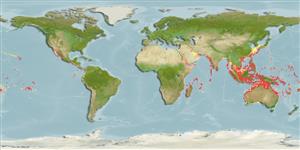>
Kurtiformes (Nurseryfishes, cardinalfishes.) >
Apogonidae (Cardinalfishes) > Apogoninae
Etymology: Siphamia: A Swazi word, siphama, for a fish.
More on author: Weber.
Environment: milieu / climate zone / depth range / distribution range
Ekologi
laut berasosiasi dengan karang; kisaran kedalaman 0 - 100 m (Ref. 90035), usually 1 - 18 m (Ref. 90102). Tropical
Indo-West Pacific: from the Red Sea south to Madagascar and east through the Maldives, Sri Lanka and India to the Andaman Sea Islands and Western Australia; north to Ryukyus; throughout the Indo-Malayan region to Vanuatu.
Size / Weight / umur
Maturity: Lm ? range ? - ? cm
Max length : 7.0 cm TL jantan/; (Ref. 89972)
deskripsi pendek
Morfologi | Morfometrik
Duri punggung (Keseluruhan (total)): 8; duri punggung lunak (Keseluruhan (total)): 9; Duri dubur 2; Sirip dubur lunak: 8. This species is distinguished by the following characters: D1 VII, D2 I,9; A II,8; pectoral fin rays 14-16; tubed lateral-line scales 20-24; median predorsal scales 4 (rarely 3 or 5); total gill rakers 2-4 + 8-10 = 11-14; developed gill rakers 1 + 7-9; gill rakers on ceratobranchial 7-8; body depth 2.3-2.7 in SL and body width 1.9-2.2 in the depth; eye diameter 2.6-3.5 in HL; first dorsal spine 2.4-4.6 in second spine; second dorsal spine 3.7-6.6, second dorsal fin spine 3.7-5.4, second anal spine 5.0-7.0, all in head length; pectoral-fin length 4.2-5.3 and pelvic-fin length 4.2-4.7 in SL; caudal peduncle length 1.5-2.1 in distance between pelvic spine insertion and anal-fin origin; preopercular edge with 23-35 serrations, the preopercular ridge smooth; scales mostly spinoid, but some cycloid scales on anterior part of body; vomer and palatines with 1-2 series of small teeth, but palatines sometimes toothless; tip of light organ on each side of tongue bound by membrane (Ref. 90035).
Found in coastal reefs and outer reef lagoons. This species forms small groups with long-spined urchins (Ref. 48635) (e.g. Diadema setosum in shallow sheltered waters, Ref. 1602); but was also found among the spines of Acanthaster planci (Ref. 90035). Feeds on zooplanktons and small invertebrates (Ref. 89972).
Distinct pairing during courtship and spawning (Ref. 205).
Gon, O. and G.R. Allen, 2012. Revision of the Indo-Pacific cardinalfish genus Siphamia (Perciformes: Apogonidae). Zootaxa 3294:1-84. (Ref. 90035)
Status IUCN Red List (Ref. 130435)
ancaman kepada manusia
Harmless
penggunaan manusia
informasi lanjut
Umur / SaizPertumbuhanpanjang-beratpanjang-panjangukuran frekuensiMorfometrikMorfologiLarvaDinamika larvapemulihanKelimpahanBRUVS
AcuanBudidaya airprofil budidaya airStrainGenetikaElectrophoresesDiturunkanPenyakit-penyakitPengolahanNutrientsMass conversion
mitraGambarStamps, Coins Misc.Suara-suaraCiguateraKecepatanTipe renangArea insangOtolithsOtakPenglihatan / visi
Alat, peralatan
laporan khas
muat turun XML
Sumber internet
Estimates based on models
Preferred temperature (Ref.
123201): 24.6 - 29.2, mean 28.3 °C (based on 4132 cells).
Phylogenetic diversity index (Ref.
82804): PD
50 = 0.5000 [Uniqueness, from 0.5 = low to 2.0 = high].
Bayesian length-weight: a=0.01479 (0.00690 - 0.03171), b=3.09 (2.91 - 3.27), in cm total length, based on LWR estimates for this (Sub)family-body shape (Ref.
93245).
Trophic level (Ref.
69278): 3.5 ±0.50 se; based on food items.
Daya lenting (Ref.
120179): Tinggi, Waktu penggandaan populasi minimum kurang dari 15 bulan (Preliminary K or Fecundity.).
Fishing Vulnerability (Ref.
59153): Low vulnerability (10 of 100).
Nutrients (Ref.
124155): Calcium = 184 [87, 344] mg/100g; Iron = 1.21 [0.66, 2.28] mg/100g; Protein = 18.4 [17.1, 19.7] %; Omega3 = 0.146 [0.069, 0.312] g/100g; Selenium = 47.6 [19.5, 104.8] μg/100g; VitaminA = 50.4 [12.9, 206.5] μg/100g; Zinc = 2.15 [1.32, 3.34] mg/100g (wet weight);
